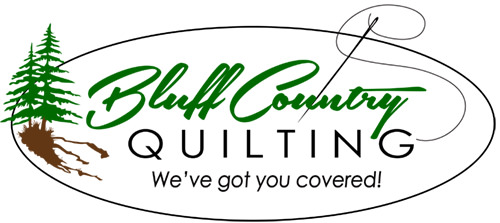Quilt Preparation for Longarm Quilting
Preparing your quilt for longarm quilting is important, because how well you prepare it will affect the quality of longarm finishing. The following tips will help guide you:

Quilt Top, Batting, and Backing — Sizing
1. Backing Fabric—Carefully square the backing fabric and make sure the backing is at least eight (8) inches longer and eight (8) inches wider than the quilt top (four inches on each of the four sides). This ensures there is enough fabric to extend the stitch design somewhat beyond the top quilt edges. Always remove the salvage edges as these refuse to stretch like the rest of the fabric. If you have to piece the backing, try to do so by running the seam(s) horizontally on the quilt back, and use a .5 inch to .625 inch seam allowance that can be pressed open. As much as possible make sure the backing lies flat; doing so avoids puckering.
When piecing the back, remember that the longarm quilter is not able to visualize the back of the quilt during the quilting process, as a result there is no way to perfectly center a design on the back. Therefore, it’s best to avoid sewing geometric designs onto the back of a quilt unless they don’t need to be centered.
2. Batting—Using good quality batting will enhance the beauty of a quilt. Some batting will shrink a lot when washed, and some will be uneven and unstable. When it comes to batting, it’s best to avoid purchasing batting sold at large department stores and discount outlets as these are usually of lessor quality. The batting stocked by Bluff Country Quilting is of very good quality, reasonably priced, and shrinks very little. Be sure to cut batting six (6) inches longer and six (6) inches wider than the quilt top.
To select among the various batting products we offer click on Services/Pricing located on the menu bar of the Bluff Country Quilting website. In addition to prices, detailed descriptions of various kinds of batting are available for review. If you have questions about which type of batting to choose, please give us a call, as we are happy to answer your questions.
3. Borders—Cutting borders and sewing them to the quilt correctly will help alleviate “wavy borders” and a quilt that appears distorted. Measure the quilt center and cut the borders to that length. Then pin the borders to the quilt, matching ends and center while easing any fullness. If borders have excessive fullness and don’t lie flat it will sometimes leave some puckering that can’t be remedied by the longarm process. If fullness is really noticeable, the longarm quilter may need to take a tuck in the fabric to make it lie flat so it can be longarmed.
4. Securing Seams—Securing stitches at the outside of the quilt by running a line of stay stitching .0125 inch from the quilt’s edge will prevent seams from pulling apart during the longarm process.
5. Trimming Threads and Seams—Clip and remove all loose and protruding threads. Trimming threads and seams on the back of the quilt top and backing will assure that only what is intended to be seen will be seen when the quilt is completed.
6. Pressing—Make sure the quilt and backing fabric is pressed and clean. Press seams in one direction as much as possible.
7. Labeling—Label the top of the quilt and backing with a safety pinned note.
8. Avoid—Do not pin, baste, or use adhesives on the quilt sandwich as it would need to be taken apart to be loaded onto the longarm take-up rails.
9. Embellishments, Prairie Points, and Pockets—Sew anything loose or extra to the quilt top after it has been longarmed. Longarm quilting machines cannot sew over or through them.

Recent Comments